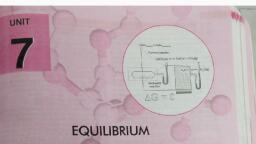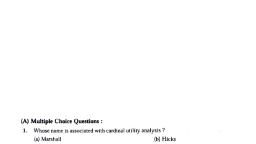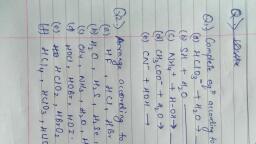Question 1 :
The following reaction that has reached equilibrium :<br/> $NaCl(s)\leftarrow \rightarrow NaCl(aq)$.<br/>What should be the nature of the solution of $NaCl$ for the phase equilibrium to exist?<br/>
Question 2 :
<b>For the equilibrium, ${ H }_{ 2 }O(s)\rightleftharpoons { H }_{ 2 }O(l)$, which of the following statement is true?</b><br/>
Question 3 :
A vessel contains 1 mole $PCl_{5(g)}$ at 4 atm and 0.5 mole $PCl_3$ formed at equilibrium. Now, equilibrium pressure of mixture is (assume ideal behavior)
Question 4 :
A chemical reaction, $A\rightleftharpoons B$, is said to be in equilibrium when:
Question 5 :
The equilibrium constant for the reaction<br>$Sr(s) + Mg^{+2}(aq) \rightleftharpoons Sr^{+2}(aq) + Mg(s)$ is $4 \times 10^{12}$ at $25^o C$<br>The $E^o$ for a cell made up of the $Sr|Sr^{+2}$ and $Mg^{+2}|Mg$ half cells (log $2 = 0.3$)
Question 6 :
Consider the process involving gaseous species,<br/>Process I: $Cl+e^{-}\rightarrow Cl^{-}$<br/>Process II: $Na^{+}+e^{-}\rightarrow Na$<br/>Process III: $S^{-}+e^{-}\rightarrow S^{2-}$<br/>Process IV: $K\rightarrow K^{+} + e^{-}$<br/>The process in which size of product is less than reactant?<br/>
Question 7 :
In a $20$ litre vessel initially $1$ - $1$ mole $CO, H_2O$, $CO_2$ is present, then for the equilibrium of $CO+H_2O\rightleftharpoons CO_2+H_2$ following is true?
Question 8 :
If $\log\dfrac { { \\ k }_{ c } }{ { k }_{ p\\  } } -\log\dfrac { 1 }{ RT } =0$, then above is true for the following equilibrium reaction:<br/>
Question 9 :
A quantity of $PCl_5$ was heated in a 10 litre vessel as $250^o C ; \, PCl_{5 (g)} \rightleftharpoons PCl_{3(g)} + Cl_{2(g)}$. At equilibrium the vessel contains 0.1 mole of $PCl_5$. 0.20 mole of $PCl_3$ and 0.2 mole of $Cl_2$. The equilibrium constant of the reaction is: <br/>
Question 11 :
The equilibrium $N_2 \, + \, O_2 \, \rightleftharpoons \, 2NO$ is established in a vessel with a capacity of 2.5 L. The initial amount of $N_2$ is 2 mol and that of $O_2$ is 4 mol. Half a mole of $N_2$ is used up at the equilibrium. The molar concentration of NO is
Question 13 :
The value of the reaction quotient $Q$, for the cell<br>$Zn(s) | Zn^{2+} (0.01\ M)\parallel Ag^{+} (1.25\ M)|Ag(s)$ is_________.
Question 14 :
A reaction in equilibrium is represented by the following equation:-<br/>$2A(s)+3B(g)\rightleftharpoons 3C(g)+D(g)+{ O }_{ 2 }$ if the pressure on the system is reduced to half of its original value then __________.
Question 15 :
Equilibrium constants for four different reactions are given as:<br/>${ K }_{ 1 }={ 10 }^{ 6 },{ K }_{ 2 }={ 10 }^{ -4 },{ K }_{ 3 }=10,K_{ 4 }=1$. Which reaction will take maximum time to attain equilibrium?
Question 16 :
The equilibrium constant for the reaction<br>$A(g) + 2B(g) \rightleftharpoons C(g)$<br>is $0.25\ dm^{6}mol^{-2}$. In a volume of $5\ dm^{3}$, what amount of $A$ must be mixed with $4$ mol of $B$ to yield $1\ mol$ of $C$ at equilibrium.
Question 17 :
${K}_{P}=0.04$ atm at $899K$ for the iequilibrium shown below. What is the equilibrium concentration of ${C}_{2}{H}_{6}$ when it is placed in a flask at $4.0$ atm pressure and allowed to come to equilibrium?<br>${C}_{2}{H}_{6}(g)\rightleftharpoons {C}_{2}{H}_{4}(g)+{H}_{2}(g)$
Question 18 :
When $CO_{2}$ dissolves in water, the following equilibrium is establishes, $CO_{2} + 2H_{2}O\rightleftharpoons H_{3}O^{+} + HCO_{3}^{-}$, for which the equilibrium constant is $3.8\times 10^{-7}$ and $pH = 6.0$. The ratio of $[HCO_{3}^{-}]/ [CO_{2}]$ is<br>
Question 19 :
The equilibrium constant for the given reaction $H_2+I_2\rightleftharpoons 2HI$ is correctly given by expression.
Question 20 :
In a chemical equilibrium $A+B \rightleftharpoons  C+D$ when one mole each of the two reactants are mixed, 0.4 mol each of the products is formed. The equilibrium constant is: 
Question 21 :
For the hypothetical reactions, the equilibrium constant $K_p$ values are given:<br/>$ A\rightleftharpoons B; K_1=2; B\rightleftharpoons C; K_2=4; C\rightleftharpoons D; K_3=3$<br/>The equilibrium constant $(K)$ for the reaction $A\rightleftharpoons D$ is:
Question 22 :
For the reaction:<br/>CH$_{4}$(g) + 2O$_{2}$(g) $\rightleftharpoons$ CO$_{2}$(g) + 2H$_{2}$O$\left (l\right)$ <br> $\Delta$H$_{r}$ = -170.8 kJmol$^{-1}$<br/>Which of the following statements is not true?<br/>
Question 23 :
For the reaction, ${ A }_{ g } + 2{ B }_{ g } \rightleftharpoons 3{ C }_{ g } + { D }_{ g }$; ${ K }_{ p }=0.05\ atm$ at 1000 K. The value of ${ K }_{ c }$ is represented by ?
Question 24 :
The equilibrium constant at 717 K for the reaction :<br/>${ H }_{ { 2 }_{ (g) } } + { I }_{ { 2 }_{ (g) } } \rightleftharpoons { 2HI }_{ (g) }$ is 50.<br/>The equilibrium constant for the reaction :<br/>${ 2HI }_{ (g) } \rightleftharpoons { H }_{ { 2 }_{ (g) } } + { I }_{ { 2 }_{ (g) } }$ at same temperature is:
Question 25 :
For the reaction, $A_\left(g\right)+2B_\left(g\right) \rightleftharpoons 3C\left(g\right) +D\left(g\right)$; ${K}_{p}=0.05$ atm at 1000K. The value of ${K}_{c}$ is represented by:
Question 26 :
The expression for equilibrium constant, $K_c$ for the following reaction is :<br/>$Fe^{3+}_(aq) + 3OH^{-}_(aq) \rightleftharpoons Fe(OH)_{3(s)}$
Question 27 :
$PCl_5, PCl_3 and Cl_2$ are at equilibrium at $500$K in a closed container and their concentrations are $0.8 \times 10^{-3} mol L^{-1}, 1.2 \times 10^{-3} mol L^{-1}$ and $1.2 \times 10^{-3} mol L^{-1}$ respectively.<br>The value of $K_c$ for the reaction:<br>$PCl_{5(g)} \rightleftharpoons PCl_{3(g)} + Cl_{2(g)}$ will be:
Question 28 :
$18.4$g of $N_2O_4$ is taken in a $1$ L closed vessel and heated till the equilibrium is reached.<br/>$N_2O_{4(g)} \rightleftharpoons 2NO_{2(g)}$<br/>At equilibrium it is found that $50\%$ of $N_2O_4$ is dissociated. What will be the value of equilibrium constant?
Question 29 :
For the reaction $2NO_{2(g)} \rightleftharpoons N_2O_{4(g)}, K_p/K_c$ is equal to :
Question 30 :
Assertion : When ${Q}_{c} ={K}_{c}$, reaction is at equilibrium.<br/>Reason : At equilibrium, $\Delta{G}^{}$ is 0.
Question 31 :
For the reaction : $H_{2(g)} + I_{2(g)} \rightleftharpoons 2HI_{(g)}$, the standard free energy is $\triangle G^0 > 0$.<br>The equilibrium constant (K) would be _______.
Question 32 :
The dissociation constants for acetic acid and HCN at $25^o$C are $1.5\times 10^{-5}$ and $4.5\times 10^{-10}$, respectively. The equilibrium constant for the equilibrium will be: $CN^-+CH_3COOH \rightleftharpoons HCN+CH_3COO^-$
Question 33 :
The following equilibria are given<br/>$N_2 + 3 H_2 \rightleftharpoons 2 NH_3, K_1$<br/>$N_2 + O_2 \rightleftharpoons 2 NO, K_2$<br/>$\displaystyle H_2 + \frac{1}{2} O_2 \rightleftharpoons H_2O, K_3$<br/>The equilibrium constant of the reaction, in terms of $K_1, K_2$ and $K_3$ is:<br/>$\displaystyle 2 NH_3 + \frac{5}{2} O_2 \rightleftharpoons 2NO + 3H_2O$<br/>
Question 34 :
$56g$ of ${N}_{2}$ and $6g$ of ${H}_{2}$ were kept at ${400}^{o}C$ in $1$ litre vessel. The equilibrium mixture contained $27.54g$ of ${NH}_{3}$. The approximate value fro ${K}_{c}$ for the above reaction in ${mol}^{2}{lit}^{2}$ is:
Question 35 :
What should be the value of $K_c$ for the reaction $2SO_{2(g)}+O_{2(g)}\rightleftharpoons 2SO_{3(g)}$, if the amount are $SO_3=48$g, $SO_2=12.8$g and $O_2=9.6$g at equilibrium and the volume of the container is one litre?
Question 36 :
$2$ mole each of $SO_3, CO, SO_2$ and $CO_2$ is taken in a one lit. vessel. If $K_c$ for<br/>$SO_3(g)+CO(g)\rightleftharpoons SO_2(g)+CO_2(g)$ is $1/9$ then:<br/>
Question 37 :
At $700 K$, the equilibrium constant, ${ K }_{ P }$, for the reaction ${ 2SO }_{ 3 }(g) \leftrightharpoons  { 2SO }_{ 2 }(g) + { O }_{ 2 }(g)$ is ${ 1.8 } \times { 10 }^{ -3 }$ kPa. The value of ${ K }_{ c }$ for the above reaction at the same temperature in moles per m$^{3}$ would be:
Question 38 :
The theoretically computed equilibrium constant for the polymerisation of formaldehyde to glucose in aqueous solution:<br>$6HCHO\rightleftharpoons C_6H_{12}O_6$<br>is $1.0\times 10^{24}$. If $1$ M-solution of glucose was taken, what should be the equilibrium concentration of formaldehyde?<br>
Question 39 :
A definite amount of solid $NH_4HS$ is placed in a flask already containing $NH_3$ gas at certain temperature and $0.50$ atm pressure. $NH_4HS$ decomposes to give $NH_3$ and $H_2S$ and total equilibrium pressure in flask is $0.84$ atm. The equilibrium constant for the reaction is:
Question 40 :
For reaction ,$2A + B \rightleftharpoons 2C, \ \ K = x$<br/>Equilibrium constant for $C \rightleftharpoons A + \dfrac{1}{2}B$ will be:
Question 41 :
Two moles of ammonia is introduced in a evacuated $500$ mL vessel at high temperature. This decomposition reaction is?<br>$2NH_3(g)\rightleftharpoons N_2(g)+3H_2(g)$<br>At the equilibrium $NH_3$ becomes $1$ mole then the $K_c$ would be:<br>
Question 42 :
In a $500$ ml capacity vessel $CO$ and $Cl_2$ are mixed to form $COCl_2$ at equilibrium, it contains $0.2$ moles of $COCl_2$ and $0.1$ mole each of $CO$ and $Cl_2$. The equilibrium constant $K_c$ for reaction $CO+Cl_2\Leftrightarrow COCl_2$, is:<br/>
Question 43 :
$4$ moles of $A$ are mixed with $4$ moles of $B$ when $2$ moles of $C$ are formed at equilibrium.<br/>What is the equilibrium constant of the given reaction: $A+B\rightleftharpoons C+D$ 
Question 44 :
The equilibrium constant $(K_c)$ for the reaction, $N_2(g)+O_2(g)\rightleftharpoons 2NO(g)$ at room temperature $T$ is $4\times 10^{-4}$. The value of $K_c$ for $NO(g)\rightleftharpoons \dfrac{1}{2}N_2(g)+\dfrac{1}{2}O_2(g)$ at the same $T$ is:
Question 45 :
The equilibrium constant for the reaction $SO_3(g)\rightleftharpoons SO_2(g)+\dfrac{1}{2}O_2(g)$ is $K_c=4.9\times 10^{-2}$. The value of $K_c$ for the reaction $2SO_2(g)+O_2(g)\rightleftharpoons 2SO_3(g)$ will be:<br/>
Question 46 :
The ${ K }_{ c }$ for the given reaction will be:<br/>${ A }_{ 2 }(g) + 2B{ (g) }\rightleftharpoons C(g) + 2D(s)$
Question 47 :
$N_2O_4(g) \rightleftharpoons 2NO_2(g);\ \ \ \Delta H = 56.9\ kJ$<br/>Which of the following will increase the yield of $NO_2$ of the equilibrium reaction?
Question 48 :
Equilibrium constant for following reactions respectively ${ K }_{ 1 },{ K }_{ 2 }\ and\ { K }_{ 3 }$ <br> ${ N }_{ 2 }+{ 3H }_{ 2 }\rightleftharpoons 2{ NH }_{ 3 }\quad  { K }_{ 1 }$ <br> ${ N }_{ 2 }+{ O }_{ 2 }\rightleftharpoons 2NO \quad { K }_{ 2 }$<br/>${ H }_{ 2 }+\frac { 1 }{ 2 } { O }_{ 2 }\rightleftharpoons { H }_{ 2 }O \quad { K }_{ 3 }$<br/>$2{ NH }_{ 3 }+\frac { 5 }{ 2 } { O }_{ 2 }\rightleftharpoons 2NO+3{ H }_{ 2 }O\quad  { K }_{ 4 }$<br/>Which of the following relation is correct?
Question 49 :
At $25^o$C, the equilibrium constants $K_1, K_2$ and $K_3$ of three reactions are:<br/>$N_2+3H_2\rightleftharpoons 2NH_3; \ \ K_1$<br/>$N_2+O_2\rightleftharpoons 2NO; \ \ K_2$<br/>$H_2+\dfrac{1}{2}O_2\rightleftharpoons H_2O; \ \ K_3$<br/>The equilibrium constants for the oxidation of $NH_3$ by oxygen to given $NO$ is:<br/>
Question 50 :
Consider the following equations for a cell reaction, then:<br/>$A+B\rightleftharpoons C+D$,    $E^o=x$ volt, $K_{eq}=K_1$<br/>$2A+2B\rightleftharpoons 2C +2D, \ \ \ E^o=y$ volt, $K_{eq}=K_2$<br/>
Question 51 :
The initial concentrations of $A$ and $B$ are same for $A = 2B \rightleftharpoons 3C$ and when equilibrium concentrations of $B$ and $C$ are same, then $K_c$ is:
Question 52 :
${X}_{2}+{Y}_{2}\rightleftharpoons 2XY$ reaction was studied at a certain temperature. In the beginning $1$ mole of ${X}_{2}$ was taken in a one litre flask and $2$ moles of ${Y}_{2}$ was taken in another $2$ litre flask. What is the equilibrium concentration of ${X}_{2}$ and ${Y}_{2}$, respectively?(Given equilibrium concentration of $[XY]=0.6{mol}^{-1}$)
Question 53 :
The equilibrium constant $K_c$ for the reaction,<br/>$SO_{3(g)} \rightleftharpoons $SO_{2(g}}$ + \dfrac{1}{2}O_2(g)$ is $4.9 \times 10^{-2}$<br/> The value of $K_c$ for the reaction, will be:<br/>$2SO_{2(g)} + O_2(g) \rightleftharpoons 2SO_3(g)$
Question 54 :
1 mole of '$A$', 1.5 mole of '$B$' and $2$ mole of '$C$' are taken in a vessel of volume one litre. At equilibrium concentration of '$C$' is $0.5$ mole/L. Equilibrium constant for the reaction, ${ A }_{ \left( g \right)  }+{ B }_{ \left( g \right)  }\rightleftharpoons { C }_{ \left( g \right)  }$ is:
Question 55 :
$2$ of ${ N }_{ 2 }$ is mixed with $6$ of ${ H }_{ 2 }$ in a closed vessel of one litre capacity. If 50% of ${ N }_{ 2 }$ is converted into ${ NH }_{ 3 }$ at equiibrium, the value of ${ K }_{ c }$ for the reaction ?<br/><br/>${ N }_{ 2 }\left( g \right) +3{ H }_{ 2 }\left( g \right) \rightleftharpoons 2{ NH }_{ 3 }\left( g \right) $<br/>
Question 56 :
Which of the following will change the value of equilibrium constant?
Question 57 :
$E^{\ominus}_{Cell}$ of $Zn/Zn^{2+}||Cu^{2+}/Cu$ is $1.10$V at $25^o$C, the equilibrium constant for the reaction, $Zn+Cu^{2+}\rightleftharpoons Cu+Zn^{2+}$ is approximately of the order of:
Question 58 :
The equilibrium constant for the isomerisation of butane at $25^oC$ is $K_c= 8$<br/>Butane $\rightarrow$ Isobutane <br/>If 5.8 g butane is introduced into a 12.5 L vessel at $25^o C$. What mass of isobutane will be present at equilibrium?
Question 59 :
Starting with one mole of $O_2$ and two moles of $SO_2$, the equilibrium for the formation of $SO_3$ was established at a certain temperature. If V is the volume of the vessel and $2x$ is the number of moles of $SO_3$ present, the equilibrium constant will be:
Question 60 :
From application of thermodynamics on chemical reaction,<br/>we get $\Delta G = \Delta G^{0} + RT$ ln Q<br/>Also $\Delta G = \Delta H -T\Delta S$.<br/>If $\Delta G = 0$, reaction is at equilibrium. <br/>If $\Delta G > 0$ reaction is non-spontaneous under given condition. $If \Delta G < 0$, reaction is spontaneous under given condition.Consider the reaction given below.<br/>$A(s) \rightleftharpoons 2B(g) \ \ \ \ \ \ \ \ \  \Delta H^{0}= 160$ KJ/mol.<br/>$\Delta S^{0} = 400$ J/mol-K  at $400$ K<br/>Which of the following is correct at $400$ K?<br/>
Question 61 :
In system $A(s) \rightleftharpoons 2B(g) + 3C(g)$ at equilibrium if concentration of $'C'$ is doubled then concentration of $B$ at equilibrium is:
Question 62 :
An equilibrium mixture, $N_{2}(g) + O_{2}(g)\rightleftharpoons 2NO(g)$ in a vessel of capacity $100$ litre contain $1\ mol\ N_{2}, 2\ mol\ O_{2}$ and $3\ mol\ NO$. Calculate the number of moles of $O_{2}$ to be added so that at new equilibrium the conc. of $NO$ is found to be $0.04\ mol/ lit$.
Question 63 :
$AB$ dissociates as $\quad 2AB(g)\rightleftharpoons 2A(g)+{ B }_{ 2 }(g)$. When the initial pressure of $AB$ is $500mm$, the total pressure becomes $625mm$ when the equilibrium is attained. Calculate ${K}_{P}$ for the reaction assuming volume remains constant.
Question 65 :
When sulphur ( in the form of $S_8$) is heated to temperature T, at equilibrium, the pressure of $S_8$ falls by 30% from 1.0 atm, because $S_8$(g) is partially converted into $S_2$(g). Find the value of $K_p$ for this reaction.
Question 66 :
If the equilibrium constant for the given reaction $NO \rightleftharpoons \frac{1}{2}N_2 + \frac{1}{2}O_2$ is $0.25$, then the equilibrium constant for the reaction $\frac{1}{2}N_2 + \frac{1}{2}O_2 \rightleftharpoons NO$ will be:<br/>
Question 67 :
For $NH_{4}HS(s)\rightleftharpoons NH_{3}(g) + H_{2}S(g)$. If $K_{P} = 64\ atm^{2}$. Equilibrium pressure of mixture is:
Question 68 :
For the reaction<br/>$5Br^{-}(aq) + 6H^{+}(aq) + BrO_{3}^{-} (aq) \rightarrow 3Br_{2}(aq) + 3H_{2}O(l)$<br/>if, $-\dfrac {\triangle [BrO_{3}^{-}]}{\triangle t} = 0.01\ mol\ L^{-1} min^{-1}$,<br/>$\dfrac {\triangle [Br_{2}]}{\triangle t}$ in $mol\ L^{-1} min^{-1}$ is:
Question 69 :
For the reaction ${ N }_{ 2 }(g)+3{ H }_{ 2 }(g)\rightleftharpoons 2{ NH }_{ 3 }(g)$ in a vessel, after the addition of equal number of moles of ${N}_{2}$ and ${H}_{2}$ equilibrium state is achieved. Which of the following is correct?
Question 70 :
The equilibrium constants for the stepwise formation of $MCl$, $MCl_2$  and $MCl_3$ are $a,\ b$ and $c$ respectively. If the equilibrium constant of formation of $MCl_3$ is K, which of the following is correct?
Question 71 :
For the equilibrium $N_2+3H_2 \rightleftharpoons 2NH_3, K_c$ at 1000 $K$ is $  2.37 \times 10^{-3}$. If at equilibrium $[N_2]=2M, [H_2]=3M$, the concentration of $NH_3$ is:
Question 72 :
$28g$ of ${N}_{2}$ and $6g$ of ${H}_{2}$ were kept at ${400}^{o}C$ in $1$ litre vessel, the equilibrium mixture contained $27.54g$ of ${NH}_{3}$. The appropriate value of ${K}_{c}$ for the above reaction can be (in ${ mole }^{ -2 }\ { litre }^{ 2 }$)
Question 73 :
Oxalic acid and donate two protons to water in successive reactions:<br>(1) $H_{2}C_{2}O_{4}(aq) + H_{2}O(l) \rightleftharpoons H_{3}O + (aq) + HC_{2}O_{4} - (aq)$<br>(2) $HC_{2}O_{5} - (aq) + H_{2}O(l) \rightleftharpoons H_{3}O + (aq) + C_{3}O_{4}^{2} - (aq)$<br>If $K_{cl} = 5.9\times 10^{-2}$ and $K_{c2} = 6.4\times 10^{-5}$ at $25^{\circ}C$, what is the value of $K_{c}$ for reaction $(3)$?<br>(3) $H_{2}C_{2}O_{4}(aq) + 2H_{2}O(l) \rightleftharpoons 2H_{3}O + (aq) + C_{2}O_{4}^{2} - (aq)$.
Question 74 :
${ K }_{ c }$ for the reaction $A+B\overset { { K }_{ 1 } }{ \underset { { K }_{ 2 } }{ \rightleftharpoons  }  }  C+D$ , is equal to: 
Question 75 :
For the reaction, $[Ag(CN_2)]^-\rightleftharpoons Ag^++2CN^-$ the equilibrium constant at 298 K is $4.0 \times 10^{-10}$. The silver ion concentration in a solution which was originally 0.12 molar n $KCN$ and 0.04 molar in $AgNO_3$, is:
Question 76 :
In a study of equilibrium,<br/>${ H }_{ 2 }\left( g \right) +{ I }_{ 2 }\left( g \right) \rightleftharpoons 2HI\left( g \right)$<br/>1 mole of ${ H }_{ 2 }$ and 3 mole of ${ I }_{ 2 }$ gave rise at equilibrium to $x$ mole of $HI$.<br/>Addition of a further 2 mole of ${ H }_{ 2 }$ gave an additional $x$ mole of $HI$. What is $x$?
Question 77 :
At 800 K a reaction mixture contained 0.5 mole of $SO_2$. 0.12 mole of $O_2$ and 5 mole of $SO_3$ at equilibrium. $K_c$ for the equilibrium $2SO_2 + O_2 \rightleftharpoons 2SO_3$ is 833 lit/ mole. If the voiume of the container is 1 litre, calculate how much $O_2$ is to be added at this equilibrium in order to get 5.2 moles of $SO_3$ at the same temperature.<br>
Question 78 :
An amount of solid $NH_4HS$ is placed in a flask already containing ammonia gas at a certain temperature and $0.50$ atm pressure Ammonium hydrogen sulphide decomposes to yield $NH_3$ and $H_2S$ gases in the flask. When the decomposition reaction reaches equilibrium, the total pressure in the flask rises to $0.84$ atm. The equilibrium constant for $NH_4HS$ decomposition at this temperature is:
Question 79 :
Consider the reactions,<br/>${ NO }_{ 2 }(g)\rightleftharpoons \cfrac { 1 }{ 2 } { N }_{ 2 }(g)+{ O }_{ 2 }(g)$; ${K}_{1}$<br/>${ N }_{ 2 }{ O }_{ 4 }\rightleftharpoons 2{ NO }_{ 2 }$; ${K}_{2}$<br/>Give the equilibrium constant for the formation of ${N}_{2}{O}_{4}$ from ${N}_{2}$ and ${O}_{2}$.
Question 80 :
Two moles of ${ N }_{ 2 }$ and two moles of ${ H }_{ 2 }$ are taken in a closed vessel of $5\ L$ capacity and suitable conditions are provided. When the equilibrium is reached, it is found that $0.6\ mole$ of ${ N }_{ 2 }$ is used up. The equilibrium concentration of ${ NH }_{ 3 }$ is________.
Question 81 :
At $298K$, the equilibrium constant of reaction.<br/>${ Zn }^{ +2 }+4{ NH }_{ 3 }\rightleftharpoons { \left[ Zn{ \left( { NH }_{ 3 } \right)  }_{ 4 } \right]  }^{ +2 }$ is ${ 10 }^{ 9 }$<br/>If ${ E }_{ { \left[ Zn{ \left( { NH }_{ 3 } \right)  }_{ 4 } \right]  }^{ +2 }/Zn+4{ NH }_{ 3 } }^{ o }=-1.03V$. The value ${ E }_{ Zn/{ Zn }^{ +2 } }$ will be: 
Question 82 :
$28\ g$ of $N_{2}$ and $6\ g$ of $H_{2}$ were kept at $400^{\circ}C$ in $1$ litre vessel, the equilibrium mixture contained $27.54\ g$ of $NH_{3}$. The approximate value of $K_{c}$ for the above reaction can be: (in $mole^{-2} litre^{2})$.
Question 83 :
If $\Delta G$ is greater than about + 20 kJ this means:<br/>
Question 84 :
Given $K_a$ values of $5.76\times 10^{-10}$ and $4.8\times 10^{-10}$ for $NH^+_4$ and $HCN$ respectively. What is the equilibrium constant for the following reaction?<br>$NH^+_4(aq.)+CN^-(aq.)\rightleftharpoons NH_3(aq.)+HCN(aq.)$<br>
Question 85 :
$I_2+I^-\rightleftharpoons  I_3{^-}$. This reaction is set up in aqueous medium. We start with $1$ mole of $I_2$ and $0.5$ mol of $I^-$ in $1$ L flask. After equilibrium, the excess of $AgNO_3$ gave $0.25$ moles of yellow ppt. Then the equilibrium constant is: <br/>
Question 86 :
At $700K$, equilibrium constant for the reaction: ${H}_{2}(g)+{I}_{2}(g)\rightleftharpoons 2HI(g)$ is $64$. If $0.5mol$ ${L}^{-1}$ of $HI(g)$ is present at equilibrium at $700K$, what are the concentration of ${H}_{2}(g)$ and ${I}_{2}(g)$ assuming that we initially started with $HI(g)$ and allowed it to reach equilibrium at $700K$?
Question 88 :
The equilibrium constant $(K_p)$ for the reaction $PCl_5(g)\rightleftharpoons PCl_3(g) $ is 16. If the volume of the container is reduced to one-half its original volume, the value of $K_p$ for the reaction at the same temperature will be:



























